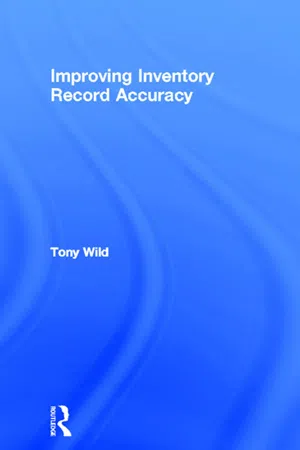
- 144 pages
- English
- ePUB (mobile friendly)
- Available on iOS & Android
Improving Inventory Record Accuracy
About this book
Record accuracy has become the focus of attention for many businesses because customers have higher expectations of the right item being delivered on time, and competitive pressures do not allow for extra stockholding. Businesses now have the opportunity to become much more effective given the correct information, the development of better communication and integration of systems. For inventory management, the pressure for most companies is to become more efficient and hold less inventory.
The accuracy of data has gradually been emerging in importance. The systems only work if the data is correct and with the introduction of integrated data, there are wide ranging repercussions for businesses that draw conclusions and make decisions based on inaccurate records.
Where there is a lot of data, there is the opportunity for many and large errors. This is often the case with inventory: many items, large varieties of different items, and fast changing inventory. Measuring how much there is becomes a challenge in many businesses such as consumer retailing and manufacturing processes where inventory changes so rapidly. With large warehouses there is also the risk of inaccurate recording so that items are not there or not in the right place.
Improving Inventory Record Accuracy initially discusses how to quantify the problem, set sensible targets for improvement and how to make the case for doing something to improve accuracy. The book then discusses why inventory records do go wrong and how to rectify the major causes of error. Finally the book illustrates the techniques with which everyone can make their records very accurate.
This is a practical book that solves a practical problem and shows the ways to improve record accuracy. Tony Wild has amassed many techniques over the years, has tried them out in practice and he presents them here in an accessible style for professional managers in logistics and stock control, retail/wholesale distribution. The book is also intended for use by students on Institute of Operations Management Certificate, DPIM, CPIM and DLM courses.
Frequently asked questions
- Essential is ideal for learners and professionals who enjoy exploring a wide range of subjects. Access the Essential Library with 800,000+ trusted titles and best-sellers across business, personal growth, and the humanities. Includes unlimited reading time and Standard Read Aloud voice.
- Complete: Perfect for advanced learners and researchers needing full, unrestricted access. Unlock 1.4M+ books across hundreds of subjects, including academic and specialized titles. The Complete Plan also includes advanced features like Premium Read Aloud and Research Assistant.
Please note we cannot support devices running on iOS 13 and Android 7 or earlier. Learn more about using the app.
Information
- Why have accurate records?
- What accuracy do we need?
- Identifying the objectives
- How to measure accuracy
- Accuracy targets
- Record pro formas
without accurate records.
- there is no inventory available to service the customer
- someone lights upon a large quantity of items which no-one knew were there
- there is a stocktake discrepancy which displeases the auditors.
targets in the short term.
- the least number of discrepancies
- the least size of discrepancies
- the least value of discrepancies.
not to suit the auditors.
Table of contents
- Front Cover
- Half Title
- Title Page
- Copyright
- Contents
- Introduction
- 1 The importance of record accuracy
- 2 Benefits from accurate records
- 3 Causes of inaccurate records
- 4 Structures to avoid inaccuracy
- 5 Responsibilities for accuracy
- 6 The right environment
- 7 Batch control
- 8 Controlling stock movement
- 9 Inventory checking
- 10 Accuracy through information technology
- 11 Record accuracy as a project
- 12 The management of record accuracy
- Appendix 1: Formula for generating stores location check digits
- Index